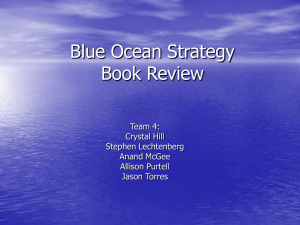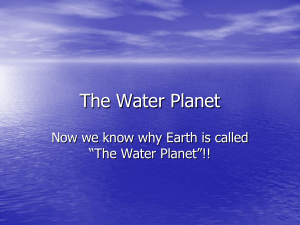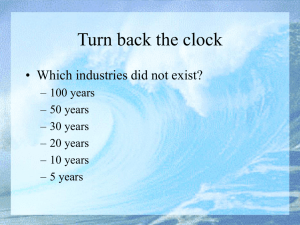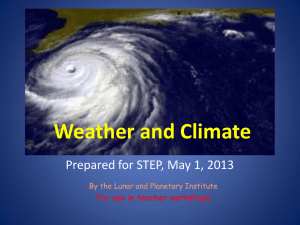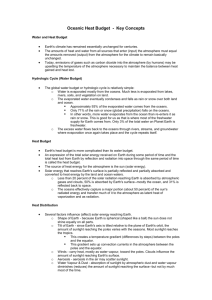Earth Teacher`s Notes Study Handout
advertisement
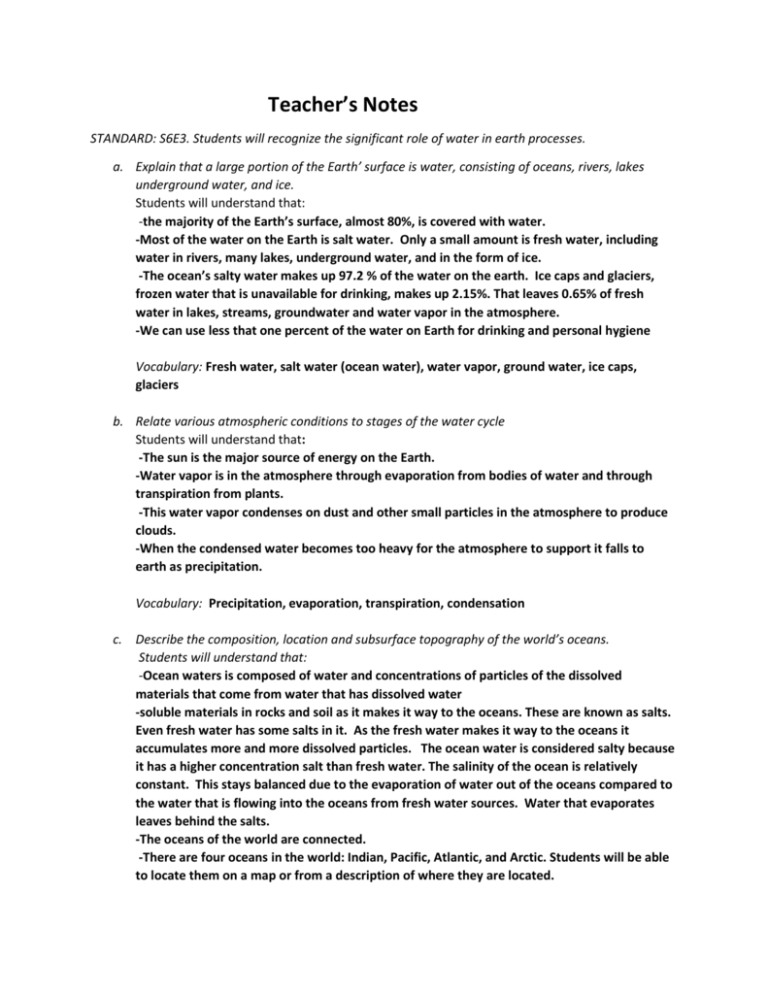
Teacher’s Notes STANDARD: S6E3. Students will recognize the significant role of water in earth processes. a. Explain that a large portion of the Earth’ surface is water, consisting of oceans, rivers, lakes underground water, and ice. Students will understand that: -the majority of the Earth’s surface, almost 80%, is covered with water. -Most of the water on the Earth is salt water. Only a small amount is fresh water, including water in rivers, many lakes, underground water, and in the form of ice. -The ocean’s salty water makes up 97.2 % of the water on the earth. Ice caps and glaciers, frozen water that is unavailable for drinking, makes up 2.15%. That leaves 0.65% of fresh water in lakes, streams, groundwater and water vapor in the atmosphere. -We can use less that one percent of the water on Earth for drinking and personal hygiene Vocabulary: Fresh water, salt water (ocean water), water vapor, ground water, ice caps, glaciers b. Relate various atmospheric conditions to stages of the water cycle Students will understand that: -The sun is the major source of energy on the Earth. -Water vapor is in the atmosphere through evaporation from bodies of water and through transpiration from plants. -This water vapor condenses on dust and other small particles in the atmosphere to produce clouds. -When the condensed water becomes too heavy for the atmosphere to support it falls to earth as precipitation. Vocabulary: Precipitation, evaporation, transpiration, condensation c. Describe the composition, location and subsurface topography of the world’s oceans. Students will understand that: -Ocean waters is composed of water and concentrations of particles of the dissolved materials that come from water that has dissolved water -soluble materials in rocks and soil as it makes it way to the oceans. These are known as salts. Even fresh water has some salts in it. As the fresh water makes it way to the oceans it accumulates more and more dissolved particles. The ocean water is considered salty because it has a higher concentration salt than fresh water. The salinity of the ocean is relatively constant. This stays balanced due to the evaporation of water out of the oceans compared to the water that is flowing into the oceans from fresh water sources. Water that evaporates leaves behind the salts. -The oceans of the world are connected. -There are four oceans in the world: Indian, Pacific, Atlantic, and Arctic. Students will be able to locate them on a map or from a description of where they are located. -Underneath the waters of the world’s oceans the earth has plains, mountains, and valleys much like those on dry land. Land is formed when the ocean floor rises higher than the level of the water. Vocabulary: Composition, subsurface topography, Salinity, salts, fresh water, salt water, sea mounts, trenches, coastal shelf, coastal slope, plains, mid-ocean ridges. Pacific, Atlantic, Indian and Artic Oceans STANDARD: S6E4 Students will understand how the distribution of land and oceans affects climate and weather. a. Demonstrate that land and water absorb and lose heat at different rates and explain the resulting effects on weather patterns. Students will understand: -Warm air rises and cool air sinks. -When the sun’s radiant heat strikes the land, it heats up. The warm land heats the air directly above (touching) the land through conduction. This warm air rises. -Water does not heat up as quickly as land, so when the warm air from the land rises the cooler air over the water takes its place. The warm air in turn rises into the atmosphere and cools off causing it to fall and convection takes place. -This unequal heating and cooling causes convection currents to form. This is how wind is created. Vocabulary: Types of energy transfer, conduction, convection, radiation, convection currents, sea breeze, land breeze, air pressure b. Relate unequal heating of land and water surfaces to form large global wind systems and weather events such as tornadoes and thunderstorms. -Warm air rises and cool air sinks. -When the sun’s radiant heat strikes the land it heats up. The warm land heats the air directly above (touching) the land through conduction. This warm air rises. -Water does not heat up as quickly as land does so when the warm air from the land rises the cooler air from over the water takes its place. The warm air in turn rises into the atmosphere and cools off causing it to fall and convection current takes place. -This unequal heating and cooling causes convection currents to form. This is how wind is created. - On a global scale, the equator receives the greatest amount of direct sunlight versus the poles. This difference in temperature creates large convection currents. These cause global wind systems. -These global wind systems curve due to the rotation of the earth. - Land in the Northern Hemisphere warms in the spring and summer. During this time warm air masses move north from Mexico, while cold air masses move south from Canada, thunderstorms and tornadoes can occur frequently during this time. Vocabulary: Global wind systems, conduction, convection, radiation, convection current, air masses c. Relate how moisture evaporating from the oceans affects the weather patterns and weather events such as hurricanes. -The sun is the major source of energy for events on the surface of the earth. -The ocean’s produce most of the water vapor in the atmosphere due to evaporation. This moisture carried along by the global wind systems brings moisture to different areas of the earth. These areas of accumulated moisture are low pressures areas and generally bring precipitation. -Hurricanes are large low pressure areas. They are caused when the warm moist air that is generated off the coast of western Africa at the equator begins to move west due to the rotation of the earth. As the warm moist air continues across the Atlantic Ocean it picks up more and more moisture. These are called tropical depressions. - If a tropical depression continues to gain strength and moisture it will become a tropical storm. If this continues it could become a hurricane. Hurricanes loose strength over land as they no longer have a source of moisture. Vocabulary: Global wind systems, hurricanes, hurricane eye, storm surge, tropical depression, tropical storm, low pressure, high pressure STANDARD: S6E6 Students will describe various sources of energy and with their uses and conservation. a. Explain the role of the sun as the major source of energy and its relationship to wind and water energy. -The sun is the major source of energy on the Earth’s surface. The unequal heating and cooling of the earth’s surfaces causes winds, ocean currents, and waves. -The sun’s energy can be used economically without changing to electricity. The direct sunlight can be used to heat water for home use, and to heat and light buildings designed to take advantage of the sun’s path through the sky. -The unequal heating of the land and water that causes wind can be harnessed to produce electricity. Vocabulary: Solar energy, solar cells, wind turbines, wind farms, hydroelectricity, electricity b. Identify renewable and nonrenewable resources. -Renewable resources can be replenished within a relatively short time period. Nonrenewable resources form very slowly, over millions of years. When present supplies are used, there will be no more. These nonrenewable resources can be used up if humans don’t use conservation strategies. - Fossil fuels are nonrenewable resources. Fossil fuels are coal, oil, and natural gas that were formed from the remains of plants that lived in seas millions of years ago. Burning of fossil fuels, which are nonrenewable resources, releases pollutants. -Nuclear power is a renewable resource but it is controversial. -Wind and solar energy are renewable energy resources. -Hydroelectricity is an inexpensive renewable electricity source. Vocabulary: Pollutants Renewable resources- fresh water, fresh air. Plants and plant products( food, natural fibers, lumber, fuel,) animal and animal products ( food, leather), wind, moving water and solar, biomass, and thermal energy Nonrenewable resources fossil fuels ( coal, oil, natural gas) soil, some metals Language -



